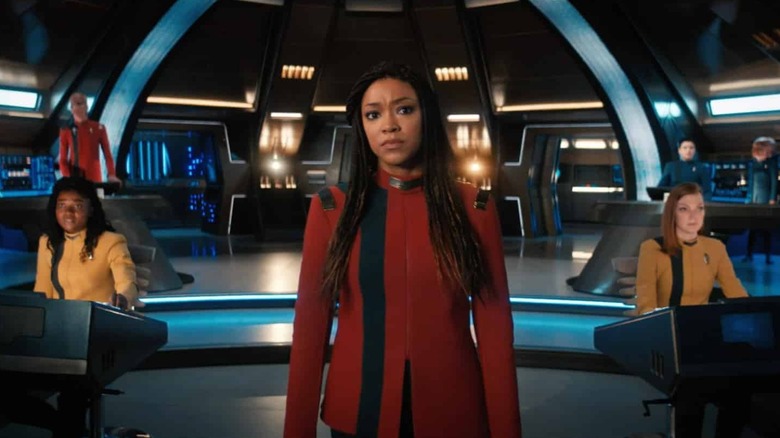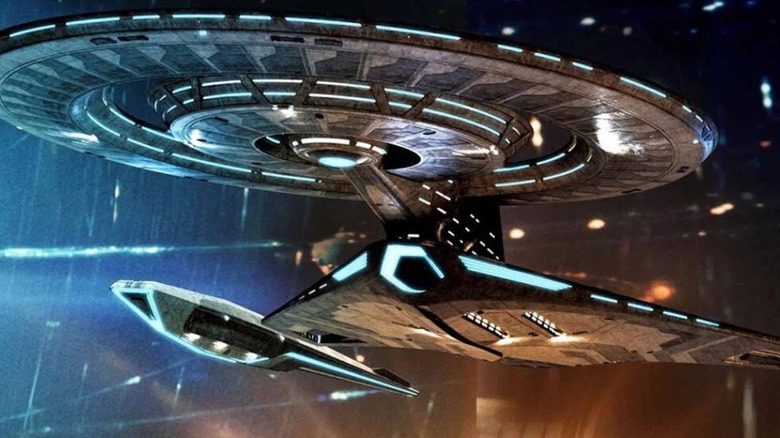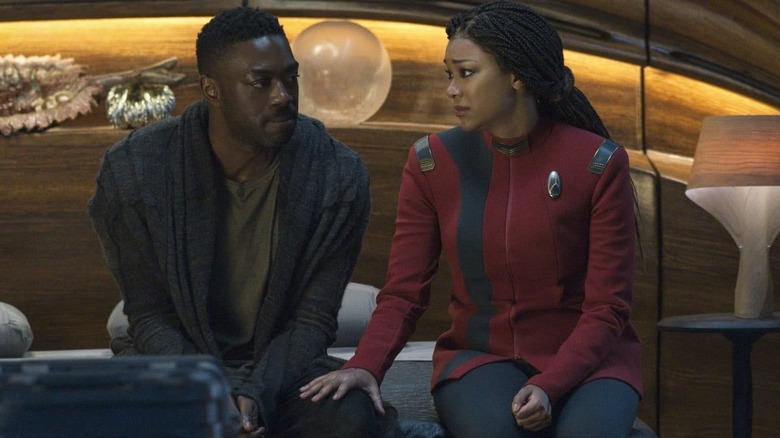How Star Trek: Discovery's Design Team Handled Hopping Into The Future
The first two seasons of "Star Trek: Discovery" felt a little bit adrift. The first season took place largely during a war between the Federation and the Klingons, and was about the Starfleet officer, Michael Burnham (Sonequa Martin-Green), who found herself in the center of it all. In what could have been an interesting "Star Trek" wrinkle, the titular ship had the ability to teleport anywhere in the galaxy using a previously undiscovered galaxy-wide network of microscopic interdimensional spores. The ramifications of a ship that can instantly carry people and supplies anywhere in the galaxy were never fully discussed, as the U.S.S. Discovery became embroiled in foolish plots about Klingon war plans and parallel universes.
The show's second season saw the ship and its crew investigating seven mysterious signals that seemed to be emanating from thousands of lightyears away all throughout the galaxy (somehow arriving on Earth instantaneously), and the Discovery had to take on Captain Pike (Anson Mount) as commanding officer. The plot involved a mysterious time traveler — ultimately Michael Burnham's mother — carrying a grave warning. The season finale saw the Discovery thrown into the distant future, fleeing a malevolent machine intelligence intent on conquering the galaxy. Handily, because of the machine's information-based hacking/proliferating habits, all record of the U.S.S. Discovery and its crew had to be permanently stricken from all Starfleet texts, keeping ordinary "Star Trek" canon mercifully in tact; now we know why Captain Picard never mentioned a ship that can teleport. Such technology would have been revolutionary and devastating to "Star Trek."
The new season, set in the future, naturally needed a full redesign. In a 2022 interview with Gold Derby, the show's cinematographer, Philip Lanyon, talked about the new premise and the thought needed to recreate 32nd century technology.
The new designs
The third season of "Discovery" began with a new premise: Can characters from the year 2258 catch up with history and technology enough to operate as Starfleet officers in the year 3188? As one might predict, the dramatic venue change required a vast rethinking of the show, its costumes, its tech, and its politics. In the 32nd century, the Federation had gone into hiding for many, many years following a galaxy-wide cataclysm nicknamed The Burn wherein all spacecraft simultaneously blew up. Hiding from a mob-like organization that took over the galaxy, the Federation managed to grow their technology, leading to a small but super-advanced fleet of futuristic ultra-vessels.
In order to make the 32nd century world, Lanyon explained that every detail needed to be thought out:
"I mean the whole timeline changed, it was quite a different show. "Discovery" actually jumps to a thousand years in the future since season two. So you know the whole methodology to the technology changed. [W]e don't do wires or plumbing or things like that anymore; ... our furniture floats and, you know, [we're] just trying to imagine this tech a thousand years in the future. What does the lighting look like? How do we use lighting? How does it change? So all those kind of questions."
Essentially, the makers of "Discovery" had to find a way to out-Trek Trek. What would "Star Trek: The Next10 Generation" look like? Would flat computer panels be required anymore, or would ship interiors now be rearranged at a whim? Are transporters still relegated to a special transporter room? As it turns out, no. Now they can be stored in a crew person's own personal communicator badge, and they can bamf all over the ship on a whim.
What will and what won't change?
The futuristic redesigns had Lanyon pondering the very nature of technology. There are some pieces of tech that haven't evolved in generations as they have already reached their most efficient designs. Paper clips don't need to be improved, for instance. Books, irons, small sailboats, and musical instruments are fundamentally the same now as they were upon their invention. Lanyon had to consider that it was possible to go too far with certain future technologies, and focus only on the kind of tech that would change. Also to consider: How would that affect people in a sociological sense?
"[Y]ou can kind of go high-tech and things like: Okay, what's even more technologically advanced [and] what's left, you know? What would humans keep? What is inherent, you know? Would people still gravitate towards a campfire, or to parties, or to communicating in person? [A]nd it's a lot of those analogue things that the audience, I think, will still connect with. So, a lot of it is about maintaining an older, kind of natural kind of vibe. For instance, you might have a light that floats in space, you know, but it would still be something kind of natural and organic in color temperature, say, or in quality."
The third and fourth seasons of "Discovery" are essentially a different show from its first two seasons, and the rest of the show (a fifth season is due in 2023) will presumably continue to take place in the 32nd century, as a high-tech, retrofitted starship expands idealistic notions of diplomacy back into a galaxy reluctant to welcome such a utopia. We can only hope that good stories emerge.


